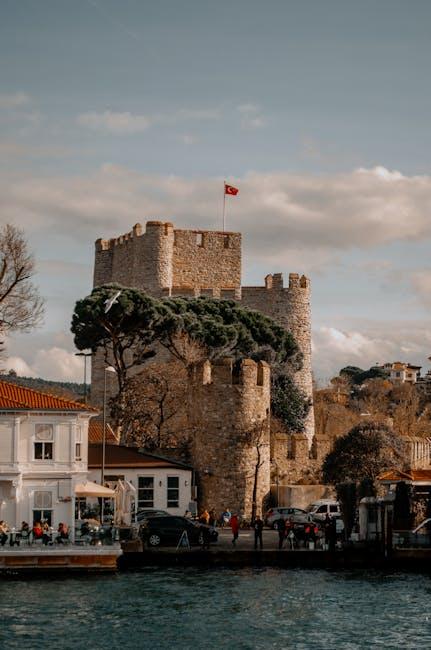In the quiet corners of ancient cities and the bustling heart of modern metropolises, the footsteps of travelers echo with stories untold and dreams fulfilled. Tourism, a global phenomenon, has woven itself into the fabric of cultural heritage, transforming how we experience the relics of the past and the traditions of the present. Yet, this vibrant tapestry is not without its frayed edges. As we stand at the crossroads of preservation and progress, a pressing question emerges: does tourism serve as a guardian of cultural heritage, breathing new life into historic wonders, or does it pose a threat, eroding the very essence it seeks to celebrate? This article delves into the intricate dance between tourism and cultural heritage, exploring the delicate balance between help and harm in a world where the past and present are forever entwined.
Balancing Act: Preserving Tradition Amidst Globalization
- Preservation of Cultural Identity: As tourism becomes a global force, it brings with it both opportunities and challenges for cultural heritage. On one hand, it can be a powerful ally in preserving tradition by generating revenue that funds restoration projects and by raising awareness about the importance of safeguarding unique cultural practices. For instance, traditional crafts and performances often find new life and appreciation through the eyes of fascinated tourists, which can invigorate local economies and encourage younger generations to learn and maintain these art forms.
- Commercialization and Authenticity Risks: However, the influx of tourists can also lead to the commercialization of culture, where traditions are modified or diluted to cater to tourist expectations. This can result in a loss of authenticity, with sacred rituals being performed outside their original context or traditional crafts being mass-produced. The delicate balance lies in ensuring that cultural experiences offered to tourists remain true to their origins, while also allowing the communities to thrive economically. The challenge is to foster a tourism model that respects and preserves cultural integrity, promoting sustainable practices that benefit both the visitors and the custodians of heritage.

Economic Boon or Cultural Bust: Analyzing Tourisms Dual Nature
The juxtaposition of economic prosperity and cultural preservation presents a fascinating duality within the tourism industry. On one hand, tourism serves as a significant economic driver, generating revenue and creating jobs in local communities. This financial influx often leads to improved infrastructure, increased investment in cultural sites, and a heightened global awareness of local heritage. On the other hand, the rapid commercialization and influx of visitors can lead to the erosion of cultural identity and the commodification of traditions. As ancient sites become tourist attractions, their authenticity may be compromised, and the local populace might find their customs and practices transformed to cater to tourist expectations.
Balancing Act: Tourism’s Benefits and Challenges
- Economic Growth: Provides financial resources that can be reinvested in preserving cultural sites.
- Cultural Exchange: Facilitates a cross-pollination of ideas and traditions, fostering global understanding.
- Preservation vs. Commodification: While funding can help preserve sites, over-commercialization risks diluting cultural significance.
- Community Involvement: Essential in ensuring that tourism development aligns with local values and needs.
Thus, tourism presents both opportunities and challenges, requiring a nuanced approach to harness its potential for cultural enrichment while safeguarding the authenticity and integrity of heritage sites.

Local Voices: Empowering Communities in Heritage Conservation
Tourism, a powerful economic driver, often walks a tightrope between being a boon and a bane for cultural heritage. On one hand, it brings much-needed funds that can be channeled into the preservation of historical sites, ensuring that these treasures are not only maintained but also appreciated by a wider audience. On the other hand, the influx of visitors can lead to wear and tear, often overwhelming the very structures that are meant to be protected. The question arises: how can communities strike a balance?
- Preservation Funding: Revenue from tourism can support conservation projects, providing resources for maintenance and restoration.
- Cultural Exchange: Tourism fosters a platform for cultural exchange, enhancing understanding and appreciation among diverse groups.
- Overcrowding Issues: Excessive visitor numbers can lead to physical damage and degrade the visitor experience, necessitating crowd management strategies.
- Commercialization Risks: The commercialization of cultural sites may dilute their authenticity, prioritizing profit over preservation.
Empowering local voices is crucial in navigating these challenges. By involving community members in decision-making processes, ensuring their perspectives and traditional knowledge are respected, a sustainable tourism model can be developed—one that benefits both heritage and the people who live alongside it.

Strategies for Sustainable Tourism: A Path to Cultural Harmony
In the quest for cultural harmony through sustainable tourism, a variety of strategies emerge as vital tools. Community involvement stands at the forefront, ensuring that local voices are heard and respected in tourism planning. By actively participating in decision-making processes, communities can help shape tourism initiatives that align with their cultural values. This collaboration not only preserves the authenticity of cultural sites but also empowers locals, offering them a stake in the economic benefits tourism brings.
Another crucial strategy is the promotion of responsible travel practices. Educating tourists about the cultural significance of their destinations fosters respect and understanding. Tour operators can facilitate this by providing comprehensive guides and immersive experiences that highlight the cultural richness of a region. Additionally, implementing sustainable infrastructure—such as eco-friendly accommodations and transportation—minimizes environmental impact, ensuring that cultural heritage sites remain intact for future generations. Together, these strategies weave a tapestry of cultural appreciation and preservation, paving the way for a harmonious coexistence between tourism and cultural heritage.






























